Traveling with Grace: Tel Aviv to Haifa
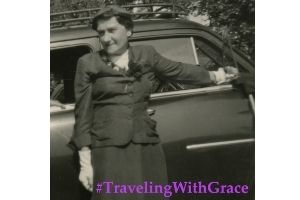
This week we continue with Grace’s 1953 trip to Israel. Special thanks go to JMM volunteer Harold Toppall for his transcriptions of Grace’s travel diary.
Thursday, May 6, 1953
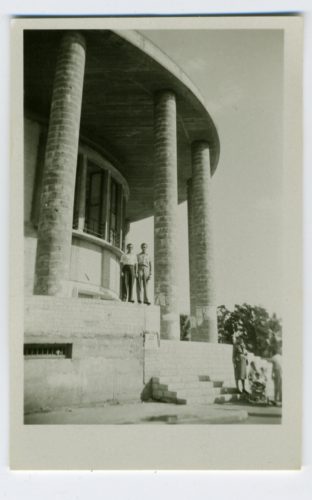
Abraham called for us at 10 a.m. & gave us a wonderful trip around Tel Aviv and environs. Everyone is out for the holiday & the shops are closed. We saw the Habima Theatre, a number of movie houses showing American films (some new, some old ones), synagogues where special services are being held. We saw beautiful homes & apt. dwellings flower bedecked. The flowers grow luxuriantly, hibiscus, morning glories, bougainvillea, roses, red poppies & daisies growing wild in the country among the wheat. There was a huge crowd on the beach (reminiscent of A.C.), boat loads going out to the Mediterranean, many paddling canoes, standing up with double paddles, everyone having a good time. I never saw such happy looking throngs.
Overhead the aviation corps flew in massed formations in jets & bombers (no doubt giving the people a great sense of security.) We saw the beautiful new Dan Hotel facing the sea & the still more imposing Nordau Plaza not yet completed. There is feverish construction everywhere & all buildings are new. The upper floors are finished first & people move in before the lower floors are finished. Most residences are built on columns which give a sort of open look to the ground floor. This, I am told, allows a greater circulation of air & keeps the buildings cooler. A number of factories are building & pipelines for irrigation are being installed thru the aid of foreign loans.
We saw a few Arabs in town dressed in their traditional bright colored loose garments having come for the holiday. In the country we saw an old mosque & minaret but in Tel Aviv the only houses of worship are synagogues as this city is 100% Jewish. We visited one children’s village run by the Mizrachi where youngsters from all countries, mostly orphans, are being assimilated into the life of the country. They are of many types & complexions all happily playing together having learned a common language. They must work on the farm half a day & some are learning trades in preference to agriculture, though that is emphasized & people are being encouraged to farm by land grants & government loans. The children are beautiful, nicely dressed & clean. There are many parks & gardens for them in the city & each age group has its own section. We rode out to Bene Berak & the Plains of Sharon. Saw the beautiful Sharon Hotel. Hotel swimming pools are as popular as in California & hotel employees speak as many languages as the Sur’s.
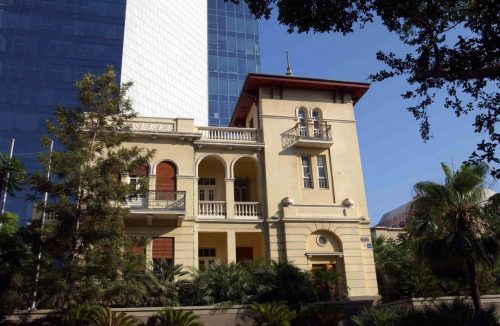
We passed the impressive American Embassy, the Russian Embassy, aloof & mysterious atop a hill, flying a big red flag with a little hammer & sickle in the corner. Also saw the pretty houses and walled-in garden of Moshe Sharett. The oranges are fairly thick on the trees, some banana & fig trees & a few date palms. We saw one Ma’Baroth (or temporary camp) with corrugated huts, which look pretty dreadful, but nearby a new project development was under construction which when completed will house these immigrants & they are doing away with these temporary dwellings as fast as possible. Though Tel Aviv is the largest & most modern city in Israel I was struck by the paucity & poor quality of the merchandise displayed in shop windows, very meager looking. This I suppose is due to the unfavorable balance of trade. Oranges, I am told, are the principle export & G.B. & the Scandinavian countries the best customers. Since the Arabs have cut off the oil supply from Iraq & Saudi Arabia, Israel buys its oil from Venezuela by trade agreements.
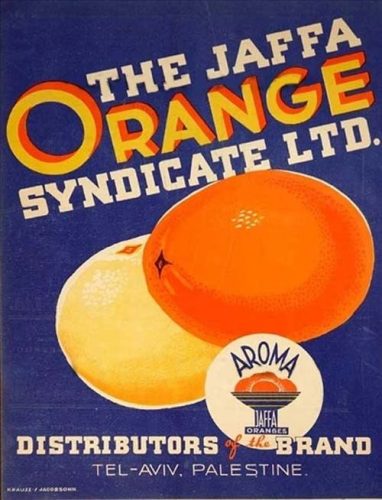
Tonight Teddy Stahl called but we could not arrange a meeting. I want to remember one story Abraham told me today. A friend of his from Poland was accustomed in that country to pray in the synagogue 3 times a day but here he only goes on Sabbath & Holy days. When asked why, he replied, “There I was afraid I’d forget I am a Jew, here there is no such danger.”
Friday, May 7, 1953
After a quiet morning we had lunch in the dining room where we saw David ben Gurion & party but I didn’t want to [b…….] had lunch in the dining room (my new friend the “singing waiter” is a great source of amusement) & then Abraham (who reminds me a lot of Leo) called for us & we started a most interesting trip. We saw the place where the Iraqi army fought the Israeli army & tried to cut the country in half. The rich orange groves in this section were completely demolished but have since been replanted. However, it will take another 10 years before the yield will equal the prewar one.
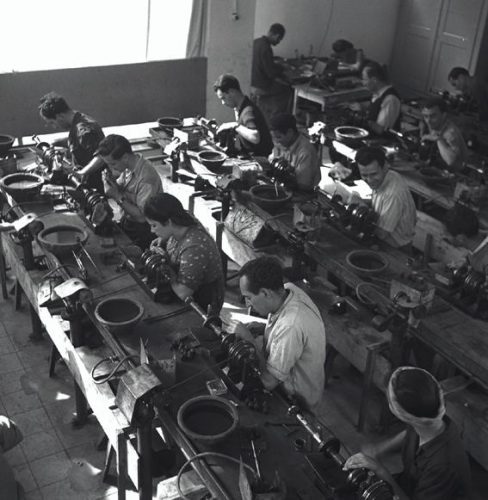
We visited Netanya (named in honor of Nathan Straus, philanthropist) which is the center of 3 important industries: diamond cutting (the workers come mainly from Holland and Belgium), leather tanneries & furniture. This town is very well planned. One side of the high road is the residential section with beautiful Synagogue, Theatre, Park & Beach; [on] the other side the industries whose smoke and fumes will not annoy the residents. We next saw The National American Paper Mill (given by the Mazer family of America) to make up the paper shortage here. We saw stacks of crates of wood pulp brought from Sweden & Finland in exchange for orange exports. Another interesting place is a settlement of aged people sponsored by Mizrachi where old people are given employment & encouraged to pursue their accustomed trades or develop new skills suited to their abilities. Also a children’s farm sponsored by Junior Hadassah.
We saw Arab Shepherds in their ancient dress tending flocks & Arab villages standing out in sad contrast to the neat modern appearance of Jewish villages. But Abraham tells us they are far better off than before the war of liberation & much cleaner. A health officer visits them periodically & the death rate much lower as well as the incidence of trachoma. The men are forbidden to have more wives than they can support or to divorce them summarily as they used to & the children must go to school. Another interesting thing we saw: putting top soil on the desert sand on which irrigation pipes are laid and Lo, the Desert blooms as the Rose.
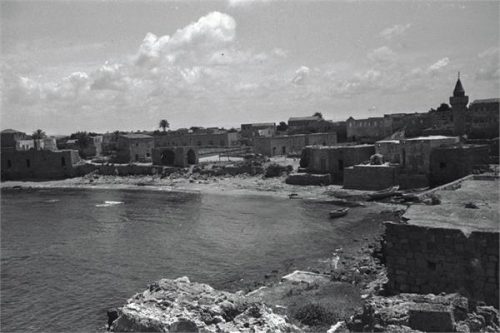
We made a detour to visit Caesaria + Abraham gave us a very fine resume of the history of this ancient town named for Ceasar Augustus & which was the rival of Jerusalem. There was always competition between the two commercially & ideologically, when one was on top the other was down. We saw the all too incomplete archeological excavations, which have not progressed due to lack of funds. Bananas rather than orange trees have been planted here, as it will not be harmful to remove them. They have exposed a beautiful statue minus head and arms, a number of five columns & part of a mosaic floor. Barbed wire is all around to discourage predatory souvenir hunters. Abraham pointed out the spot where Peter & Paul sailed for Rome to preach the Gospel.
We continued on to Haifa. Saw the artists’ colony of Zichron, perched atop a hill. Came in to Haifa just before sunset, a beautiful city on the slopes of the Mediterranean & the largest port in the Middle East. It is built on 3 levels, the top on Mt. Carmel, which in the Bible is the synonym for Beauty. Most of the homes are built of white stone quarried here + shine in the like marble. We rode up to the beautiful park named for Baron de Rothschild (he is buried with his wife in a simple mausoleum overlooking the city where his remains were transferred from France not long ago as requested in his will). We are beginning to see some birds with light blue wings in this region, which Abraham calls the Blue Bird of Gallilee. Arrived at Hotel Maggido, a charming modern hostelry where we have a lovely room & balcony overlooking the sea.
Saturday, May 8, 1953

Enjoyed a nice long rest today. Sat on our pretty balcony, read my prayers & gazed out on the aquamarine sea with no perceptible horizon. Below is a beautiful flower garden, people wandering in & out, sitting at little tables eating & drinking, the weather is perfect, about 60° dry and bracing. In the distance we see the old Carmelite Monastery, first Christian church I’ve seen in Israel. Tonight we have a visitor – Mr. Uriel Caspi, in the ship building trade. He speaks English well & we have a very interesting conversation until about 11.
Sunday, May 9, 1953
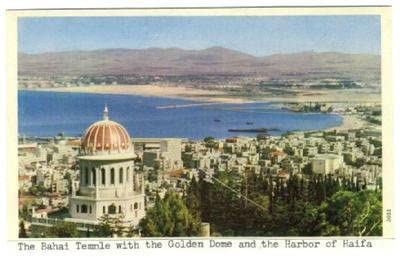
This morning we drove all around Haifa, a really prosperous looking city (they have parking meters here) & a large industrial area near the harbor including a Kaiser-Frazer assembly plant, & a cement factory which won competitive bidding with several other countries to build a new army airport in Turkey. We saw the very impressive City Hall with a carving of a ship on its façade. But the greatest jewel of the city is the Bahai Temple with hit huge golden dome set in the midst of a magnificent formal garden with all manner of tropical & semi tropical flowers & trees, entered thru majestic wrought iron gates. All thru the park are placed conspicuously iron cast of peacocks & eagles which seem to be emblematic of this sect. We noticed some Iranian people walking thru the grounds which Abraham says the government helps to maintain & I don’t wonder as it is a major attraction. We next visited Naharia, another pretty resort town on the Mediterranean with good beach, several fine swimming pools & bath houses, movie theatres, hotels & all these places have the most tastefully landscaped parks. The flowers are a riot of bright colors.
Then we went on to Acre, city of the Bible & one of the most fascinating places in this superlatively fascinating land. Here Napoleon’s fleet was defeated in attempting to conquer the Middle East. The old walls of the city, which rise perpendicularly from the sea, are 12 ft. thick & show no perceptible erosion after 4000 yrs. It is about 80% Arab & the houses look ancient but fairly clean. It has a very oriental look & there is a beautiful mosque (the oldest & most famous in the country) which the Israel govt. is helping to restore. When we were parked a group of little children gathered round us to look at our American Flag & they all wanted to the touch the “kegel”. One said he was Iraqui, another Rumanian, another Sini (he reallly looked Chinese) but all were chattering in “Ivrit” & asked me if we were American Yehudim. We then returned to the Meggido forlunch. Today I had my first taste of Israeli (Valencia) oranges, very small but sweet & juicy & thin skinned. A very sweet young girl Linda Lurie (here called Gavriella) from Louisiana who is a dental hygienist & here on a grant from the Zionist Organization of America, accompanied us on our trips today & added no little to our enjoyment. Tho her parents are in America she intends to remain here where she has a sweetheart.
After lunch we started out for Nazareth stopping on the way to visit a moshav & the kibbutz Mirra (a moshav is a cooperative farm but with individual family living quarters & a share in the profits; a kibbutz has communal living quarters & the profits are pooled for the common advantage of the settlement, also the children are cared for away from the parents.
Nazareth, a hill town, with narrow precipitous streets is a town of Arab Christians with a sprinkling of Jews & many, many churches of all denominations, as primitive looking as it must have appeared 2000 years ago. Here we are besieged by venders, but finally dispersed them. Young girls, women & little girls are going to the wells with pitchers or tin cans balanced neatly on their heads to fetch water. Young & old ride miniature donkeys which are almost hidden beneath their burden. Turbaud shepherds pilot herds of black goats thru the streets. The country between Nazareth and Caua is extremely fertile. The roads are steep & serpentine reminding me a little of Mexico & the many cacti adds to the resemblance.
The Wedding Church at Cana from The Faithful Traveler on Vimeo.
Cana is smaller than Nazareth but equally picturesque & here we saw the church where Jesus performed the miracle at the wedding of turning water into wine. A little further on is the unique village of Piquiin the only place where Jews have lived continuously since bible days, side by side with their Druse neighbors (whose prophet is Jethro, father-in-law of Moses): thru Saracin, Turkish Crusader invasions, the British mandate, Arab wars, & now a part of the State of Israel. The road gradually descends & presently we glimpse the Sea of Galilee or as they call it “Yam Kinnereth,” which means Violin Sea as it is supposed to resemble a violin in shape.
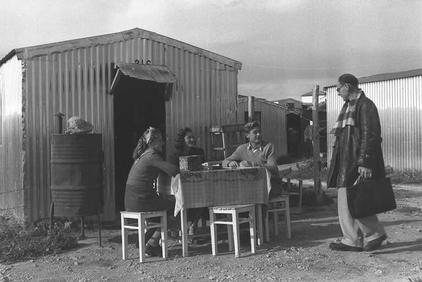
The ancient town of Tiberias nestles at one side 600 ft. below sea level. On the opposite shores are the Syrian hills. The first thing I notice in the town is the enormous temporary camp or ma’abrot, the largest I have seen. They resemble Quonset huts only the roofs are flat. Many were lighted up & we could see inside, meager furniture, 5 & 6 people huddled into one room about 6 x 10 ft. Herod the Tetrarch named this town, which he built about 42 B.G. after Tiberius Caesar. After the destruction of Jerusalem it became the metropolis of the Jewish nation. In the middle of the 2nd century the Sanhedran transferred here & it became the center of Jewish learning. A celebrated school here worked on & codified much of the Mishnah & Gemora. Also, the code of vowel symbols to help preserve true pronunciation originated here & it became one of 4 sacred cities the others being Jerusalem, Hebron & Safad. The last we can see from a distance when riding around the upper end of the lake.

We arrived at the pretty hotel Galei Kinnereth (waves of Kinnereth) in time for dinner. Our room has a balcony facing a luxuriant garden & the lake, the water glistens thru the thick foliage in the twilight & it is very peaceful here.
Thanks for reading “Traveling with Grace,” a series where we’re sharing (and annotating) posts from the travel diaries of Grace Amelia Hecht, native Baltimorean, b. 1897 and d. 1955. As mentioned in my introductory post transcription errors sometimes occur and I’ve made my best guesses where possible, denoted by [brackets]. – Rachel Kassman, marketing manager
